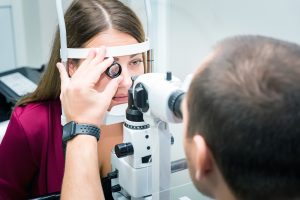Glaucoma is one of the leading causes of irreversible blindness worldwide, and unfortunately, it often develops with no noticeable symptoms until significant vision loss has occurred. This makes early glaucoma screening crucial in managing the disease effectively. Dr. Karen Rudo, a renowned ophthalmologist, emphasizes the significance of early detection and the role it plays in preserving vision for people at risk of this debilitating condition.
In this article, we explore the different types of glaucoma, its risk factors, the importance of early screening, and the treatment options available to manage the disease before it leads to permanent vision loss.

What is Glaucoma?
Understanding the Most Common Types of Glaucoma
Glaucoma is not just one disease but a group of conditions that cause damage to the optic nerve, the crucial part of the eye that transmits visual information to the brain. The disease typically develops slowly and painlessly, and symptoms may go unnoticed until significant damage has been done. The two most common types of glaucoma are:
Primary Open-Angle Glaucoma
The most prevalent form of glaucoma is primary open-angle glaucoma (POAG), which accounts for about 90% of cases. This condition is characterized by a gradual buildup of pressure inside the eye, called intraocular pressure (IOP). This pressure can cause damage to the optic nerve over time. Since this increased pressure does not cause pain, individuals often don’t realize they have the condition until significant damage has been done.
Symptoms of Primary Open-Angle Glaucoma:
-
Peripheral vision loss: The first noticeable sign of damage to the optic nerve.
-
Gradual vision changes: Symptoms may progress slowly over time, making early detection essential.
As Dr. Rudo explains, “Eye pressure cannot be felt and doesn’t cause pain. Until the end stages, glaucoma has no symptoms. Once optic nerve damage occurs, it is not repairable.” Therefore, regular glaucoma screening is essential to detect the condition before vision loss becomes irreversible.
Angle-Closure Glaucoma
Unlike open-angle glaucoma, angle-closure glaucoma is an acute condition that occurs when the drainage angle in the eye becomes blocked, causing a sudden increase in intraocular pressure. This form of glaucoma is more common in East Asian populations and tends to affect women more frequently. Symptoms of this type of glaucoma develop rapidly and require immediate attention.
Symptoms of Angle-Closure Glaucoma:
-
Hazy vision
-
Severe eye pain
-
Red eye
-
Headaches that may lead to nausea
Angle-closure glaucoma is considered a medical emergency, and if treated promptly, vision may recover. However, without immediate treatment, it can lead to permanent vision loss.
Why Early Glaucoma Screening is Crucial
Risk Factors for Glaucoma
Several factors increase an individual’s likelihood of developing glaucoma. These include:
-
Age: The risk increases significantly after the age of 40.
-
Ethnicity: People of African, Hispanic, and Asian descent are at higher risk.
-
Family history: A family history of glaucoma can increase your risk.
-
Eye injuries: Previous trauma to the eye can lead to glaucoma later in life.
-
Use of corticosteroids: Long-term use of corticosteroids can increase intraocular pressure.
-
Diabetes: This condition has been linked to an increased risk of developing glaucoma.
Dr. Rudo recommends baseline glaucoma screening by the age of 40, as many of these risk factors become more significant as you age.
What Happens During a Glaucoma Screening?
Comprehensive Eye Exam for Early Detection
A complete eye exam is the most effective way to detect glaucoma. During the exam, an ophthalmologist will assess the intraocular pressure and examine the optic nerve for any signs of damage. The process typically includes:
-
Measuring intraocular pressure (IOP): This test is commonly done using a device that gently puffs air into the eye to measure the pressure inside.
-
Optic nerve assessment: The doctor will check for any visible damage to the optic nerve head, which is indicative of glaucoma.
-
Peripheral vision test: A computerized test, known as perimetry, will assess your side (peripheral) vision to detect any early signs of damage.
-
Eye drainage check: A test to evaluate whether the drainage angle in the eye is open or blocked.
By regularly monitoring these aspects, your ophthalmologist can detect changes early and begin treatment to prevent further damage.
Treatment Options for Glaucoma
Medications and Laser Treatment
If glaucoma is detected early, treatment options are available to help manage the condition and preserve vision. The primary goal of treatment is to lower intraocular pressure (IOP) to prevent further optic nerve damage.
Medications:
The most common treatment for glaucoma is the use of prescription eye drops that help reduce eye pressure. These drops work in various ways, such as reducing fluid production or increasing the outflow of fluid from the eye.
Laser Treatment:
For some patients, a laser procedure may be used to treat glaucoma. The laser trabeculoplasty procedure can help improve the drainage of fluid from the eye, reducing intraocular pressure. Many patients opt for laser treatment to avoid the need for daily eye drops.
Surgery:
In more advanced cases where medications and laser treatment are not effective, surgery may be required. Surgical options, such as trabeculectomy or tube shunt surgery, can create a new drainage path for fluid in the eye.
FAQs
What age should I get tested for glaucoma?
It is recommended to start baseline screening by age 40. If you have risk factors such as a family history or are over 40, you should schedule regular screenings thereafter.
Can glaucoma be cured?
While there is no cure for glaucoma, it can be effectively managed with treatments that lower eye pressure and prevent further damage to the optic nerve.
How is glaucoma diagnosed?
Glaucoma is diagnosed through a comprehensive eye exam, which includes tests for intraocular pressure, optic nerve health, and peripheral vision.
What are the symptoms of glaucoma?
Most people with glaucoma experience no symptoms until significant damage has been done. Early signs include peripheral vision loss and gradual changes in vision.
How can I lower my risk of glaucoma?
Maintaining a healthy lifestyle, controlling conditions like diabetes, and scheduling regular eye exams can help reduce your risk of glaucoma.




